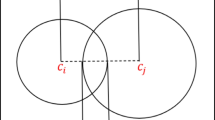Abstract
Both empty and heavy car flows should be taken into consideration in the study of the Optimization Model of Car Flow Organization, in the Loading End of Heavy Haul Railway. Firstly, through the analysis of empty and heavy car flow organization in the semi-closed heavy haul railway loading end, comprehensive optimization model based on ability of station and railway can be established in order to obtain car flow organization scheme with minimum residence time of both empty and heavy cars in the loading end. Secondly, immune clone algorithm is applied to solve the model in which the objective function is regarded as antibody and the constrained condition is considered as antigen to calculate the affinity, further to conduct the mutation, based on information entropy. Mutation is conducted according to the affinity. In the solving process, reproduction can be realized with the use of immune clone selection algorithm. Besides, premature convergence can be prevented by using the antibody concentration which can control the population size. Finally, simulation results show that the average search time of the proposed algorithm is reduced by 36 and 51% respectively compared with the GA and PSO.



Similar content being viewed by others
References
Ahuja RK, Jha KC, Liu J (2007) Solving real-life railroad blocking problems. Interfaces 37(5):404–419
Bojovic N, Boskovic B, Milenkovic M, Sunjic A (2010) A two-level approach to the problem of rail freight car fleet composition. Transport 25(2):186–192
Barros VH, Costa TS, Oliveira ACM, Lorena LAN (2011) Model and heuristic for berth allocation in tidal bulk ports with stock level constraints. Comput Ind Eng 60(4):606–613
Chen L, He SW, Wang BH (2013) Optimization of resource allocation for rail container terminals based on internet of things technology. In: Proceedings of fourth international conference on transportation engineering, Chengdu, pp 2896–2911
Chou Js, Tsai CF, Chen ZY, Sun MH (2014) Biological-based genetic algorithms for optimized disaster response resource allocation. Comput Ind Eng 74:52–67
Fügenshuh A, Homfeld H, Schülldorf H (2015) Single-car routing in rail freight transport. Transp Sci 49(1):130–148
Hu ZH (2011) A container multimodal transportation scheduling approach based on immune affinity model for emergency relief. Expert Syst Appl 38(3):2632–2639
Ji LJ, Lin BL, Wang ZM (2009) Study on the optimization of car flow organization for loading area based on logistics cost. J China Railw Soc 31(2):1–6
Liu XB, Lv Q (2011) Immune clonal selection algorithm for flexible job-shop scheduling problem. Control Decis 34(10):781–785
Lin BL, Qiao GH (2008) Iterative algorithm of railway network empty cars distribution based on restriction of route capacity. China Railw Sci 29(1):93–96
Liu J, He SW, Song R, Li J (2014) Research on model and algorithm of flow assignment of busy truck railway lines based on freight products. J China Railw Soc 36(7):1–7
Luo J, Xue F, Peng Q (2013) Space-time networks construction analysis based on railway wagon-flow adjustment. In: Proceedings of fourth international conference on transportation engineering, Chengdu, China, pp 1394–1399
Qin YM, Wu TF, Zhou DJ (2010) Proceedings of international conference of logistics engineering and management, Chengdu, China, pp 2908–2914
Redmer A, Żark J, Sawicki P, Maciejewski M (2012) Heuristic approach to fleet composition problem. Procedia Soc Behav Sci 54:414–427
Shang R, Du B, Ma H, Jiao L, Xue Y, Stolkin R (2016) Immune clonal algorithm based on directed evolution for multi-objective capacitated arc routing problem. Appl Soft Comput 49:748–758
Soleimani H, Chaharlang Y, Ghaderi H (2018) Collection and distribution of returned-remanufactured products in a vehicle routing problem with pickup and delivery considering sustainable and green criteria. J Clean Prod 172:960–970
Upadhyay A, Bolia N (2014) Combined empty and loaded train scheduling for dedicated freight railway corridors. Comput Ind Eng 76:23–31
Upadhyay A, Bolia NB (2014) An optimization based decision support system for integrated planning and scheduling on dedicated freight corridors. Int J Prod Res 52(24):7416–7435
Xu XS, Zhang S, He Q (2008) Novel immune clonal selection optimization programming. J Syst Simul 20(6):1536–1540
Zhang D, Cai S, Ye F, Si YW, Nguyen TT (2017) A hybrid algorithm for a vehicle routing problem with realistic constraints. Inf Sci 394–395:167–182
Zhu SN, Cao JM, Zhao Q (1993) The synthetical optimization of wagon flow organization. J China Railw Soc 15(3):59–69
Zhao P, Zhang JC, Tang NG (2010) Study on the optimization model of car flow organization, in the loading area of heavy Haul railway based on the combined trains. China Railw Sci 31(6):116–121
Acknowledgements
This study is supported by The National Natural Science Foundation of China (61403022); supported by Beijing Natural Science Foundation (J160003); supported by the Fundamental Research Funds for the Central Universities (2017JBM030)
Author information
Authors and Affiliations
Corresponding author
Ethics declarations
Conflict of interest
The authors declare that there is no conflict of interest regarding the publication of this paper.
Rights and permissions
About this article
Cite this article
Jing, Y., Zhang, Z. A study on car flow organization in the loading end of heavy haul railway based on immune clonal selection algorithm. Neural Comput & Applic 31, 1455–1465 (2019). https://doi.org/10.1007/s00521-018-3396-2
Received:
Accepted:
Published:
Issue Date:
DOI: https://doi.org/10.1007/s00521-018-3396-2




